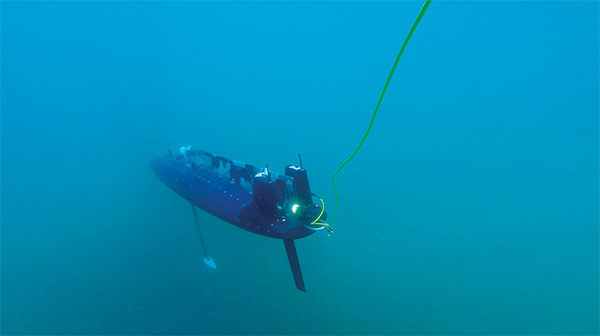Already home to one of the country’s most diverse clusters of ocean-related industries, Mississippi is on a mission to shore up its Blue Economy.
With 62 miles of shoreline and a robust network of research-related resources, including the Mississippi Research Consortium (a partnership among the state’s four research universities: Jackson State University, Mississippi State University, the University of Mississippi and the University of Southern Mississippi [USM]), Stennis Space Center, the Mississippi Polymer Institute, the National Oceanic and Atmospheric Administration (NOAA), and the U.S. Navy’s Meteorological Center, the Mississippi Gulf Coast is an ideal home base for developing world-changing technologies and fostering next-generation innovations.
Mississippi has long been home to several leading marine companies anchored in the state, including Huntington Ingalls Industries, Halter Marine, United States Marine, Seemann Composites and many others. The region is also home to a thriving energy and petroleum sector, which includes the Chevron Pascagoula Refinery in Jackson County.
Key to growing the Blue Economy in the state is a new initiative launched in July by USM.
The Gulf Blue Initiative aims to capitalize on the region’s geography and marine resources to position Mississippi’s Gulf Coast as a global leader in ocean- and maritime-related technologies. According to NOAA’s 2021-2025 Blue Economy Strategic Plan, the sector is expected to double in value from $1.5 trillion to $3 trillion over the next decade globally. Up to one-third of jobs along the Mississippi Gulf Coast are in ocean-related industries, including shipbuilding, submersible vehicle and ocean sensors, fisheries, aquaculture, cargo shipping and defense. The initiative is focused on an initial set of six blue tech innovation clusters, including uncrewed maritime systems, ocean-friendly plastics, precision aquaculture, smart ports, sea-space systems and coastal data.
With a presence across Mississippi’s three coastal counties, USM offers a wealth of expertise in ocean-related sectors. Recently, USM made several strategic investments in infrastructure to support ocean innovation. Located in Gulfport’s emerging Blue Economy Innovation District (BEID), the historic Gulf & Ship Island Building is a cornerstone facility for the new Gulf Blue initiative. It features a 24-hour connected space for blue tech innovators. The facility will be home to the Gulf Blue Accelerator Program, which will launch next year to help blue tech startups reduce development time and catalyze growth.
BEID is conveniently located in downtown Gulfport and provides easy access to the Port of Gulfport, rail, interstate highways, and the Gulfport-Biloxi International Airport. This central location also helps connect innovators and startups with academic and research expertise and students at USM’s coastal locations.
In addition to its beautiful, beachfront Gulf Park campus in Long Beach, USM offers a plethora of assets across the Mississippi Coast, including the Hydrographic Science Research Center, Center for Research Fisheries and Development, Gulf Coast Geospatial Center, Thad Cochran Marine Aquaculture Center, Marine Research Center, ample lab space at the Roger F. Wicker Center for Ocean Enterprise and a fleet of research vessels. In 2023, USM will launch a new $100 million National Science Foundation oceanographic research ship named for civil rights hero Gilbert R. Mason.
All of these key resources combine to create what USM Senior Associate Vice President for Coastal Operations Shannon Campbell calls the Mississippi Gulf Coast’s many “nodes of innovation.”
“When you start connecting these nodes of innovation across the coast, it does start to paint a larger picture of all the innovation that is actually happening,” she says, pointing to the breadth of research occurring across USM, federal and private facilities in Hancock, Harrison and Jackson counties. “The interconnectedness of researchers working together across those nodes is what really elevates us and gives us a competitive advantage.”
The university has established several collaborations with private blue tech companies, including Ocean Aero, which recently relocated from California to Mississippi; AI Control Technologies Inc., which is focused on developing automation for the aquaculture industry; and SeaAhead, a blue tech startup platform. The innovations these companies and others like them are developing are also key to the success of the Gulf Blue initiative.
“We are thrilled to support USM’s leadership in the blue economy future,” said Alissa Peterson, co-founder and executive director of SeaAhead. “We believe that the Gulf Coast has an important role to play in the development of innovations related to the ocean and that the creation of the Gulf Blue brand will support the competitiveness of this effort globally.”
Ocean Aero Relocates to Mississippi
Ocean Aero, Inc. recently relocated its headquarters and manufacturing operations from San Diego, California, to Gulfport. The company, which makes autonomous underwater and surface vehicles, selected a 67,000-sq.-ft. warehouse at the Port of Gulfport.
Ocean Aero CEO Kevin Decker said the company considered sites in Texas, Florida, California, Virginia and New England before choosing the Mississippi Gulf Coast.
“We believe that Mississippi has a unique ecosystem of maritime defense, science, and offshore energy interests supported by an active academic community that ultimately make the state the best choice for us to do business,” Decker explained. Decker noted that local organizations were instrumental in the company’s relocation decision, among them USM, the Harrison County Development Commission and Mississippi Power Company. In addition, the Mississippi Development Authority will assist in equipment relocation and workforce training.
“There are many advantages of having Gulfport as a home to our ocean-based enterprise,” he said. “From a readily available marine industry labor force for both manufacturing and engineering jobs to partnership opportunities with great academic institutions like USM to favorable state and federal legislators helpful to business in general, to lower-than-average costs of doing business across the board, the opportunities for upside are boundless.
Though the biggest factor for us was the pure proximity to some of our biggest customers who are also present along the Gulf Coast like NOAA, DHS, the U.S. Navy, and others. Overall, the maritime ‘Gulf Blue’ economy is thriving in Gulfport, and we’re excited to be a part of it.”
This Investment Profile was prepared under the auspices of the Mississippi Development Authority. For more information, visit mississippi.org.

